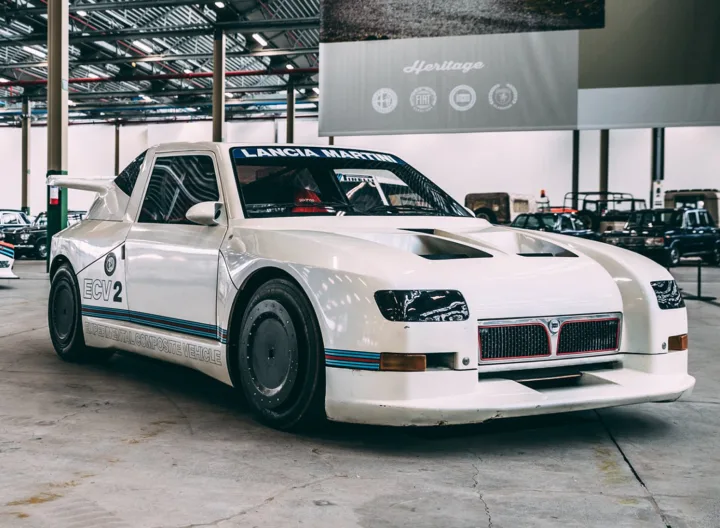Lancia ECV2: too good for its time
During the 1986 World Rally Championship, Abarth engineers were already working on designing a completely new car to replace the Lancia Delta S4. They created a futuristic prototype with extensive use of composite materials, hence its name ECV (Experimental Composite Vehicle). The experimental model also featured a new engine equipped with a revolutionary compressor called Triflux. Thus, already in 1986, Lancia already had a car with the specifications of the new Group S, which was to debut the following season. The chassis was designed by the company engineer Sergio Limone, who was responsible for the design and experiments for the Squadra Corse Lancia HF. He also created the innovative bodywork using Kevlar and carbon fiber. The engine was wrapped in a special "cradle", while the rigid cockpit and the rest of the superstructure were made of separate panels. Only the front part of the chassis was made of conventional steel tubes, so that it could be repaired and replaced more quickly magazin de piese auto online.

New composite materials have also been used for powertrain components and wheels to further reduce weight. Overall, while providing higher torsional rigidity than the Delta S4, the car weighs around 20% less. The engine, designed by Abarth technical director Claudio Lombardi, has the same displacement as the Delta S4. Lombardi also incorporates his famous Triflux system into the ECV, with a cross-flow cylinder head and two turbochargers. The ingenious scheme with transversely positioned intake and exhaust valves allows the engine to be more effectively “compressed” even from low revs, but also to provide more power at high revs. From the first tests, the results were very encouraging: 600 hp were reached, which is around 100 hp more than the Delta S4.
However, after several tragic incidents during the 1986 season, the Federation decided not to make the transition from Group B to Group S and the ECV project was put on the back burner. As a result, all of Abarth's efforts were redirected towards the new Lancia Delta HF 4WD, which met the specifications of the newly created Groups A and N, and marked the beginning of a new era, becoming the most successful car in the company's sporting history.
Work on the futuristic Lancia ECV, with its innovative composite bodywork and revolutionary Triflux engine, was not completely stopped, however. As early as late 1986, the ECV prototype, decorated in the red Lancia-Martini livery, was shown at the Bologna Motor Show. Both the public and the professionals were very impressed with the car, but disappointed that it would not be able to compete. In the meantime, the Lancia sports team decided to continue the experiments with the ECV, making some significant changes to the bodywork.
Italian designer Carlo Gaino created new shapes that were noticeably different from those of the Delta S4. Thus, in 1988, the ECV 2 was created, with all the changes made aimed at improving aerodynamics, the most significant of which was the rear spoiler. While on the Delta S4 and ECV it was placed at the end of the roof, on the ECV 2 the results of the wind tunnel led to its complete “separation” from the body and its placement at mid-height. Therefore, the rear part was modified and shortened. The large air intakes on the rear pillars, characteristic of the Delta S4 and ECV, were removed, and only the slot at the end of the roof remained, directing air to the engine compartment. The front hood was completely redesigned, with a large double opening. The massive front spoiler is connected to the radiator grille, which resembles that of the Delta 4WD, and the headlights are much more aerodynamically shaped. The side skirts also improve aerodynamics, and the rims are equipped with external disc brakes, also made of composite material, to improve cooling. The body also has another specific feature related to the color, which is a combination of Bianco Perla (pearl white) with a light blue and blue-red stripe with the Martini Racing livery. This specific shade was later used in the special limited edition Lancia Delta HF Integrale Evoluzione.
- 2025-10-27 - Bioattack on the varnish (retrospection)
- 2025-10-26 - 95.9 percent drop in profit for Porsche
- 2025-10-25 - This Audi 100 TDI had a fuel consumption of just 1.76 liters
- 2025-10-24 - Another section with dividing posts to increase safety
- 2025-10-23 - KS-80: the latest model from the legendary Zündapp brand
- 2025-10-22 - This W 140 costs 20 times more than the S 600
- 2025-10-21 - Volkswagen expands its plant in Poland for the new electric Crafter
- 2025-10-20 - Dongfeng Box's welds failed the Euro NCAP crash test
- 2025-10-19 - Double success for Dacia Sandriders: Sébastien Loeb triumphs in Morocco, Edouard Boulanger is world champion among navigators
- 2025-10-18 - The end of an era: VW Touareg goes electric












